1 of 17
Download to read offline


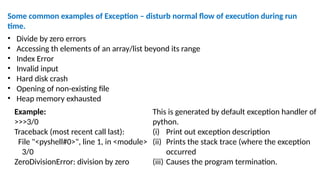
![Example:
>>>l1=[1,2,3]
Traceback (most recent call last):
File "<pyshell#3>", line 1, in <module>
l1[4]
IndexError: list index out of range
Example:
>>>l1=[1,2,3]
>>>li[4]
Traceback (most recent call last):
File "<pyshell#2>", line 1, in <module>
li[4]
NameError: name 'li' is not defined. Did you mean: 'l1'?](https://image.slidesharecdn.com/exceptionhandling-241128151426-be362f63/85/Exception-handling-pptxnn-h-4-320.jpg)
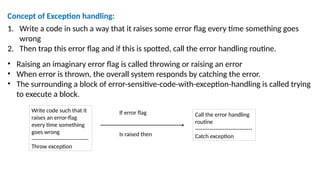
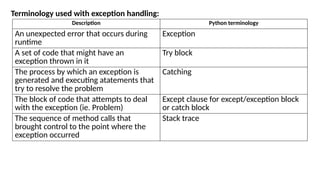
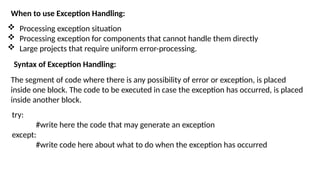



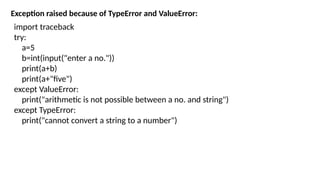
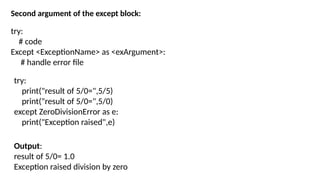


![Finally block:
Finally block can be used just like except block but any code placed inside finally block
must execute, whether the try block raised an exception or not.
try:
#statements that may raise exception
[except:
# handle exception here]
finally:
#statements that will always run
Example:
try:
fh=open(ŌĆ£poems.txtŌĆØ , ŌĆØr+ŌĆØ)
fh.write(ŌĆ£Adding new lineŌĆØ)
except:
print(ŌĆ£Exception has occurredŌĆØ)
finally:
print(ŌĆ£goodbye!!!ŌĆØ)
The except block is executed only when
exception has occurred but finally block
will be executed always in the end.](https://image.slidesharecdn.com/exceptionhandling-241128151426-be362f63/85/Exception-handling-pptxnn-h-15-320.jpg)
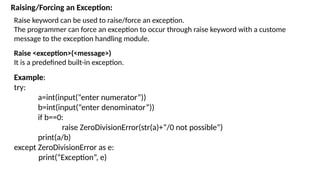

Recommended
Exception Handling on 22nd March 2022.ppt



Exception Handling on 22nd March 2022.pptRaja Ram Dutta
╠²
The document discusses Python exception handling. It defines what exceptions are, how to handle exceptions using try and except blocks, and how to raise user-defined exceptions. Some key points:
- Exceptions are errors that disrupt normal program flow. The try block allows running code that may raise exceptions. Except blocks define how to handle specific exceptions.
- Exceptions can be raised manually using raise. User-defined exceptions can be created by subclassing built-in exceptions.
- Finally blocks contain cleanup code that always runs whether an exception occurred or not.
- Except blocks can target specific exceptions or use a generic except to handle any exception. Exception arguments provide additional error information.Error and exception in python



Error and exception in pythonjunnubabu
╠²
Errors in Python programs are either syntax errors or exceptions. Syntax errors occur when the code has invalid syntax and exceptions occur when valid code causes an error at runtime. Exceptions can be handled by using try and except blocks. Users can also define their own exceptions by creating exception classes that inherit from the built-in Exception class. The finally block gets executed whether or not an exception was raised and is used to define clean-up actions. The with statement is also used to ensure objects are cleaned up properly after use.Exceptions overview



Exceptions overviewBharath K
╠²
An exception is an error condition or unexpected behavior encountered during program execution. Exceptions are handled using try, catch, and finally blocks. The try block contains code that might throw an exception, the catch block handles the exception if it occurs, and the finally block contains cleanup code that always executes. Common .NET exception classes include ArgumentException, NullReferenceException, and IndexOutOfRangeException. Exceptions provide a standard way to handle runtime errors in programs and allow the programmer to define specific behavior in error cases.Exception



Exceptionabhay singh
╠²
The document discusses exception handling in C#. It describes how exceptions are represented by classes derived from the System.Exception class. It explains the try, catch, throw, and finally keywords used to handle exceptions. Specific exception classes like DivideByZeroException are mentioned. Examples are provided to demonstrate catching individual exceptions, catching all exceptions, and throwing exceptions manually. Finally, it discusses using finally blocks and exploring exception object properties like Message and StackTrace.Ch-1_5.pdf this is java tutorials for all



Ch-1_5.pdf this is java tutorials for allHayomeTakele
╠²
The document discusses exception handling in Java. It defines exceptions as abnormal conditions that occur during runtime and disrupt normal program flow. It describes different types of exceptions like checked, unchecked, and errors. It explains concepts like exception handling syntax using try, catch, finally blocks to maintain program flow. It provides examples to demonstrate exception handling and resolving exceptions in catch blocks.Py-║▌║▌▀Żs-9.ppt



Py-║▌║▌▀Żs-9.pptwulanpermatasari27
╠²
Python provides exception handling to deal with errors during program execution. There are several key aspects of exception handling in Python:
- try and except blocks allow code to execute normally or handle any raised exceptions. except blocks can target specific exception types or be general.
- Standard exceptions like IOError are predefined in Python. Developers can also define custom exception classes by inheriting from built-in exceptions.
- Exceptions have an optional error message or argument that provides more context about the problem. Variables in except blocks receive exception arguments.
- The raise statement intentionally triggers an exception, while finally blocks ensure code is always executed regardless of exceptions.Exception Handling



Exception HandlingReddhi Basu
╠²
This document discusses exception handling in C++ and Java. It defines what exceptions are and explains that exception handling separates error handling code from normal code to make programs more readable and robust. It covers try/catch blocks, throwing and catching exceptions, and exception hierarchies. Finally, it provides an example of implementing exception handling in a C++ program to handle divide-by-zero errors.43c



43cSireesh K
╠²
The document discusses exception handling in C#. It describes how exceptions provide a way to transfer control when errors occur. It explains the try, catch, finally, and throw keywords used in exception handling and provides examples of handling different types of exceptions using these keywords. It also discusses user-defined exceptions and how to create custom exception classes by inheriting from the Exception class.Java: Exception



Java: ExceptionTareq Hasan
╠²
Sub: Java
Topic: Exception
║▌║▌▀Ż number: 6
Presented by: Mahbubul Islam (MMI)
Lecturer, Dept. of CSE
University of Rajshahiunit 4 msbte syallbus for sem 4 2024-2025



unit 4 msbte syallbus for sem 4 2024-2025AKSHAYBHABAD5
╠²
The Intel 8086 microprocessor, designed by Intel in the late 1970s, is an 8-bit/16-bit microprocessor and the first member of the x86 family of microprocessors1. HereŌĆÖs a brief overview of its internal architecture:
Complex Instruction Set Computer (CISC) Architecture: The 8086 microprocessor is based on a CISC architecture, which supports a wide range of instructions, many of which can perform multiple operations in a single instruction1.
Bus Interface Unit (BIU): The BIU is responsible for fetching instructions from memory and decoding them, while also managing data transfer between the microprocessor and memory or I/O devices1.
Execution Unit (EU): The EU executes the instructions1.
Memory Segmentation: The 8086 microprocessor has a segmented memory architecture, which means that memory is divided into segments that are addressed using both a segment register and an offset1.
Registers: The 8086 microprocessor has a rich set of registers, including general-purpose registers, segment registers, and special registersUNIT-3.pptx Exception Handling and Multithreading



UNIT-3.pptx Exception Handling and MultithreadingSakkaravarthiS1
╠²
The document discusses exception handling and multithreading in Java. It covers exception handling basics like checked and unchecked exceptions. It describes try, catch, throw, throws and finally keywords used in exception handling. It also discusses multiple catch clauses, nested try blocks and built-in exceptions. For multithreading, it defines processes and threads, and how to create multiple threads and handle thread synchronization and priorities in Java.What is Exception Handling?



What is Exception Handling?Syed Bahadur Shah
╠²
Exceptions provide a way to handle runtime errors or unexpected events in a program by transferring control to exception handlers. Common types of exceptions include divide by zero errors, out of bounds array access, invalid input, hardware errors, and file errors. C++ exception handling uses the try, catch, and finally keywords. The try block identifies code that can throw exceptions. The catch block handles exceptions. The finally block allows cleanup code to run regardless of exceptions. The throw keyword throws a specific exception object. Exception handling separates error handling from normal code to make programs more readable, robust, and fault tolerant.Z blue exception



Z blue exceptionNarayana Swamy
╠²
Exceptions represent errors that occur during program execution. The try-catch block allows exceptions to be handled gracefully. A try block contains code that might throw exceptions, while catch blocks specify how to handle specific exception types if they occur. Checked exceptions must either be caught or specified in a method's throws clause, as they represent conditions outside the programmer's control. Unchecked exceptions like NullPointerException indicate programming errors and do not require catching or specifying.Exception handling



Exception handlingRaja Sekhar
╠²
JAVA EXCEPTION HANDLING
N.V.Raja Sekhar Reddy
www.technolamp.co.in
Want more interesting...
Watch and Like us @ https://www.facebook.com/Technolamp.co.in
subscribe videos @ http://www.youtube.com/user/nvrajasekharUNIT III 2021R.pptx



UNIT III 2021R.pptxRDeepa9
╠²
The document discusses exception handling and multithreading in Java. It defines exceptions as unexpected events that occur during program execution and disrupt normal flow. There are three types of exceptions: checked exceptions which occur at compile time; unchecked exceptions which occur at runtime; and errors which are problems beyond a program's control. The try, catch, finally keywords are used to handle exceptions. The document also discusses creating threads and synchronization in multithreaded programming.UNIT III 2021R.pptx



UNIT III 2021R.pptxRDeepa9
╠²
The document discusses exception handling and multithreading in Java. It begins by defining exceptions as unexpected events that occur during program execution and disrupt normal flow. There are three categories of exceptions: checked exceptions which occur at compile time; unchecked exceptions which occur at runtime; and errors which are problems beyond a program's control. The document then covers how to handle exceptions using try, catch, finally and throw keywords. It provides examples of built-in and user-defined exceptions. The document concludes by explaining Java's multithreading model, how to create and manage threads, set thread priorities and states, and techniques for inter-thread communication.Java-Exception Handling Presentation. 2024



Java-Exception Handling Presentation. 2024nehakumari0xf
╠²
Java Exception Handling Presentation is only for Educational purpose. Happy learning :)
05.02. 2024
Exception Handling In Java Presentation. 2024



Exception Handling In Java Presentation. 2024kashyapneha2809
╠²
Exception handling in Java allows programs to handle errors and unexpected conditions gracefully. There are three main types of exceptions: checked exceptions which must be declared, unchecked exceptions which do not need to be declared, and errors which are usually unrecoverable. The try/catch block is used to catch exceptions, with catch blocks handling specific exception types. Finally blocks contain cleanup code and are always executed regardless of exceptions. Methods can declare exceptions they may throw using the throws keyword. Programmers can also create custom exception classes. Exception Handling.ppt



Exception Handling.pptFaisaliqbal203156
╠²
The document discusses exception handling in Java. It covers goals of exception handling like throwing, designing, and catching exceptions. It explains the difference between checked and unchecked exceptions. It discusses separating error handling code from regular code using try/catch blocks. Exceptions allow propagating errors up the call stack. Finally, it provides examples of declaring, catching, and throwing custom exceptions.Exception handling in java



Exception handling in javagopalrajput11
╠²
The document discusses exception handling in Java. It provides definitions of exceptions as abnormal conditions or events that disrupt normal program flow. Exception handling allows the normal flow to be maintained by catching and handling exceptions. There are two main types of exceptions - checked exceptions which are compiler-checked, and unchecked exceptions which occur at runtime. The try-catch block is used to catch exceptions, while finally blocks ensure cleanup code is always executed.Exception Handling in python programming.pptx



Exception Handling in python programming.pptxshririshsri
╠²
Here...this ppt shows the programming language named "python".In python,file 'exception handing' and their examples & exercises are given.it gives the clear idea of the python exception.exceptionvdffhhhccvvvv-handling-in-java.ppt



exceptionvdffhhhccvvvv-handling-in-java.pptyjrtytyuu
╠²
This document discusses exception handling in Java. It defines exceptions as runtime errors that occur when unexpected conditions arise in a program. It describes different types of errors like runtime, logic, and syntax errors. It then explains how to handle exceptions through try-catch blocks and throwing exceptions. It provides examples of handling exceptions like dividing by zero to demonstrate these concepts.Exceptionhandling



ExceptionhandlingDrHemlathadhevi
╠²
1. Exception handling separates error-handling code from normal code to make programs more readable and robust.
2. There are two main types of exceptions: checked exceptions which must be caught or declared, and unchecked exceptions which do not typically need to be caught.
3. The try-catch block is used to catch exceptions, where code after the try is run inside a try block and any matching exceptions are caught and handled in corresponding catch blocks.iatrogenic damages of ortho treatment - sunitha.ppt



iatrogenic damages of ortho treatment - sunitha.pptPseudoPocket
╠²
iatrogenic damages of ortho treatment - sunitha.pptMore Related Content
Similar to Exception handling.pptxnn h (20)
Exception Handling



Exception HandlingReddhi Basu
╠²
This document discusses exception handling in C++ and Java. It defines what exceptions are and explains that exception handling separates error handling code from normal code to make programs more readable and robust. It covers try/catch blocks, throwing and catching exceptions, and exception hierarchies. Finally, it provides an example of implementing exception handling in a C++ program to handle divide-by-zero errors.43c



43cSireesh K
╠²
The document discusses exception handling in C#. It describes how exceptions provide a way to transfer control when errors occur. It explains the try, catch, finally, and throw keywords used in exception handling and provides examples of handling different types of exceptions using these keywords. It also discusses user-defined exceptions and how to create custom exception classes by inheriting from the Exception class.Java: Exception



Java: ExceptionTareq Hasan
╠²
Sub: Java
Topic: Exception
║▌║▌▀Ż number: 6
Presented by: Mahbubul Islam (MMI)
Lecturer, Dept. of CSE
University of Rajshahiunit 4 msbte syallbus for sem 4 2024-2025



unit 4 msbte syallbus for sem 4 2024-2025AKSHAYBHABAD5
╠²
The Intel 8086 microprocessor, designed by Intel in the late 1970s, is an 8-bit/16-bit microprocessor and the first member of the x86 family of microprocessors1. HereŌĆÖs a brief overview of its internal architecture:
Complex Instruction Set Computer (CISC) Architecture: The 8086 microprocessor is based on a CISC architecture, which supports a wide range of instructions, many of which can perform multiple operations in a single instruction1.
Bus Interface Unit (BIU): The BIU is responsible for fetching instructions from memory and decoding them, while also managing data transfer between the microprocessor and memory or I/O devices1.
Execution Unit (EU): The EU executes the instructions1.
Memory Segmentation: The 8086 microprocessor has a segmented memory architecture, which means that memory is divided into segments that are addressed using both a segment register and an offset1.
Registers: The 8086 microprocessor has a rich set of registers, including general-purpose registers, segment registers, and special registersUNIT-3.pptx Exception Handling and Multithreading



UNIT-3.pptx Exception Handling and MultithreadingSakkaravarthiS1
╠²
The document discusses exception handling and multithreading in Java. It covers exception handling basics like checked and unchecked exceptions. It describes try, catch, throw, throws and finally keywords used in exception handling. It also discusses multiple catch clauses, nested try blocks and built-in exceptions. For multithreading, it defines processes and threads, and how to create multiple threads and handle thread synchronization and priorities in Java.What is Exception Handling?



What is Exception Handling?Syed Bahadur Shah
╠²
Exceptions provide a way to handle runtime errors or unexpected events in a program by transferring control to exception handlers. Common types of exceptions include divide by zero errors, out of bounds array access, invalid input, hardware errors, and file errors. C++ exception handling uses the try, catch, and finally keywords. The try block identifies code that can throw exceptions. The catch block handles exceptions. The finally block allows cleanup code to run regardless of exceptions. The throw keyword throws a specific exception object. Exception handling separates error handling from normal code to make programs more readable, robust, and fault tolerant.Z blue exception



Z blue exceptionNarayana Swamy
╠²
Exceptions represent errors that occur during program execution. The try-catch block allows exceptions to be handled gracefully. A try block contains code that might throw exceptions, while catch blocks specify how to handle specific exception types if they occur. Checked exceptions must either be caught or specified in a method's throws clause, as they represent conditions outside the programmer's control. Unchecked exceptions like NullPointerException indicate programming errors and do not require catching or specifying.Exception handling



Exception handlingRaja Sekhar
╠²
JAVA EXCEPTION HANDLING
N.V.Raja Sekhar Reddy
www.technolamp.co.in
Want more interesting...
Watch and Like us @ https://www.facebook.com/Technolamp.co.in
subscribe videos @ http://www.youtube.com/user/nvrajasekharUNIT III 2021R.pptx



UNIT III 2021R.pptxRDeepa9
╠²
The document discusses exception handling and multithreading in Java. It defines exceptions as unexpected events that occur during program execution and disrupt normal flow. There are three types of exceptions: checked exceptions which occur at compile time; unchecked exceptions which occur at runtime; and errors which are problems beyond a program's control. The try, catch, finally keywords are used to handle exceptions. The document also discusses creating threads and synchronization in multithreaded programming.UNIT III 2021R.pptx



UNIT III 2021R.pptxRDeepa9
╠²
The document discusses exception handling and multithreading in Java. It begins by defining exceptions as unexpected events that occur during program execution and disrupt normal flow. There are three categories of exceptions: checked exceptions which occur at compile time; unchecked exceptions which occur at runtime; and errors which are problems beyond a program's control. The document then covers how to handle exceptions using try, catch, finally and throw keywords. It provides examples of built-in and user-defined exceptions. The document concludes by explaining Java's multithreading model, how to create and manage threads, set thread priorities and states, and techniques for inter-thread communication.Java-Exception Handling Presentation. 2024



Java-Exception Handling Presentation. 2024nehakumari0xf
╠²
Java Exception Handling Presentation is only for Educational purpose. Happy learning :)
05.02. 2024
Exception Handling In Java Presentation. 2024



Exception Handling In Java Presentation. 2024kashyapneha2809
╠²
Exception handling in Java allows programs to handle errors and unexpected conditions gracefully. There are three main types of exceptions: checked exceptions which must be declared, unchecked exceptions which do not need to be declared, and errors which are usually unrecoverable. The try/catch block is used to catch exceptions, with catch blocks handling specific exception types. Finally blocks contain cleanup code and are always executed regardless of exceptions. Methods can declare exceptions they may throw using the throws keyword. Programmers can also create custom exception classes. Exception Handling.ppt



Exception Handling.pptFaisaliqbal203156
╠²
The document discusses exception handling in Java. It covers goals of exception handling like throwing, designing, and catching exceptions. It explains the difference between checked and unchecked exceptions. It discusses separating error handling code from regular code using try/catch blocks. Exceptions allow propagating errors up the call stack. Finally, it provides examples of declaring, catching, and throwing custom exceptions.Exception handling in java



Exception handling in javagopalrajput11
╠²
The document discusses exception handling in Java. It provides definitions of exceptions as abnormal conditions or events that disrupt normal program flow. Exception handling allows the normal flow to be maintained by catching and handling exceptions. There are two main types of exceptions - checked exceptions which are compiler-checked, and unchecked exceptions which occur at runtime. The try-catch block is used to catch exceptions, while finally blocks ensure cleanup code is always executed.Exception Handling in python programming.pptx



Exception Handling in python programming.pptxshririshsri
╠²
Here...this ppt shows the programming language named "python".In python,file 'exception handing' and their examples & exercises are given.it gives the clear idea of the python exception.exceptionvdffhhhccvvvv-handling-in-java.ppt



exceptionvdffhhhccvvvv-handling-in-java.pptyjrtytyuu
╠²
This document discusses exception handling in Java. It defines exceptions as runtime errors that occur when unexpected conditions arise in a program. It describes different types of errors like runtime, logic, and syntax errors. It then explains how to handle exceptions through try-catch blocks and throwing exceptions. It provides examples of handling exceptions like dividing by zero to demonstrate these concepts.Exceptionhandling



ExceptionhandlingDrHemlathadhevi
╠²
1. Exception handling separates error-handling code from normal code to make programs more readable and robust.
2. There are two main types of exceptions: checked exceptions which must be caught or declared, and unchecked exceptions which do not typically need to be caught.
3. The try-catch block is used to catch exceptions, where code after the try is run inside a try block and any matching exceptions are caught and handled in corresponding catch blocks.Recently uploaded (20)
iatrogenic damages of ortho treatment - sunitha.ppt



iatrogenic damages of ortho treatment - sunitha.pptPseudoPocket
╠²
iatrogenic damages of ortho treatment - sunitha.pptEthics in Clinical Research Regulation including historical perspective for (...



Ethics in Clinical Research Regulation including historical perspective for (...Om Mahajan
╠²
MRA - 103T, Unit -2, This is best of content you can find.Adulterants screening in Herbal products using Modern Analytical Techniques



Adulterants screening in Herbal products using Modern Analytical Techniques28SamruddhiKadam
╠²
Basic introduction to adulteration in Herbal products, M Pharm Pharmaceutical Analysis Semester 2
Basic types of Adulterations in herbal products.
Modern hyphenated techniques used in determination of adulteration of herbal drugs which includes TLC, HPTLC, HPLC, LC-MS, LC-NMR, SFC, LC-IR,etc.
Various modern analytical techniques used in Quantification of Adulterants present in herbal product.
Examples of various drugs causing adulteration in Herbal products.
Regulatory Framework for Drug Import Under the Drugs and Cosmetics Act, 1940 ...



Regulatory Framework for Drug Import Under the Drugs and Cosmetics Act, 1940 ...Dr.Navaneethakrishnan S
╠²
This presentation provides an in-depth overview of drug import regulations under the Drugs and Cosmetics Act, 1940, and its Rules, 1945. It covers key topics such as prohibited imports, import of new drugs, personal use import regulations, import licensing requirements, and storage conditions for scheduled drugs. It also explains government restrictions, exemptions, and penalties for violations. This guide is essential for pharmacy students, regulatory professionals, and individuals involved in the import and distribution of pharmaceutical products in India.Ranitidine Recall:- Regulatory Response to NDMA Contamination



Ranitidine Recall:- Regulatory Response to NDMA ContaminationSuyash Jain
╠²
Ranitidine Recall:- Regulatory Response to NDMA Contamination
introduction about ranitidine
rise and fall of ranitidine:- drug discovery pipeline
NDMA Contamination: A Ticking Time Bomb
VALISURA laboratory
Claims by VALISURA
Testing Methods for NDMA
Regulatory Procedure Timeline
European Medical Agency
CHMP(Committee for Medicinal Products for Human Use)
usfda
Recall
what are recalls
21CFR
Recall Process: A Step-by-Step Guide
Regulatory actions
(FDA recall, EMA recommendations)
Guidelines to consumers
Alternatives to ranitidine
What Ranitidine Taught Us About Drug Safety?
Let's Talk About It: Ovarian Cancer (Making Meaning after a Cancer Diagnosis)



Let's Talk About It: Ovarian Cancer (Making Meaning after a Cancer Diagnosis)RheannaRandazzo
╠²
Making meaning from hardship is a complex conversation. Many cancer survivors feel the delicate balance between making meaning and the internalized or external pressure that often follows a cancer diagnosis. Questions such as ŌĆ£What now?ŌĆØ are common when treatment ends. Well-meaning friends and family may subtly (or not so subtly) expect us to behave or view the world differently. If figuring out who you are now feels puzzling, join us on Wednesday, December 11th. Together, we will discuss how changes in your identity and perspective are a valid and essential part of this journey. Research has shown us how making meaning after hardship facilitates adjustment and well-being. diabetes mcq by NAME ANKUSH GOYAL (1).pdf



diabetes mcq by NAME ANKUSH GOYAL (1).pdfDr Ankush goyal
╠²
Diabetes Mellitus: A Comprehensive Overview
Introduction
Diabetes mellitus is a chronic metabolic disorder characterized by hyperglycemia due to defects in insulin secretion, insulin action, or both. It affects millions of people worldwide and is a major cause of morbidity and mortality due to its associated complications. This document provides an in-depth discussion of the types, pathophysiology, clinical features, diagnosis, management, and complications of diabetes mellitus.
Types of Diabetes Mellitus
1. Type 1 Diabetes Mellitus (T1DM)
Autoimmune destruction of pancreatic beta cells
Absolute insulin deficiency
Typically presents in childhood or adolescence
Requires lifelong insulin therapy
2. Type 2 Diabetes Mellitus (T2DM)
Characterized by insulin resistance and relative insulin deficiency
Strong genetic predisposition
Associated with obesity and sedentary lifestyle
Managed with lifestyle modifications, oral hypoglycemics, and sometimes insulin
3. Gestational Diabetes Mellitus (GDM)
Hyperglycemia first recognized during pregnancy
Increases risk of complications for both mother and baby
Usually resolves postpartum but increases the risk of T2DM later in life
4. Other Specific Types
Monogenic diabetes (MODY, neonatal diabetes)
Secondary diabetes (due to pancreatic diseases, endocrinopathies, drug-induced, etc.)
Pathophysiology
Diabetes results from impaired insulin secretion, action, or both, leading to chronic hyperglycemia. The key mechanisms include:
Type 1 Diabetes: Autoimmune destruction of beta cells, leading to absolute insulin deficiency.
Type 2 Diabetes: Insulin resistance in peripheral tissues and inadequate compensatory insulin secretion by beta cells.
GDM: Hormonal changes in pregnancy lead to insulin resistance and beta-cell dysfunction.
Clinical Features
Symptoms of Hyperglycemia:
Polyuria (excessive urination)
Polydipsia (excessive thirst)
Polyphagia (excessive hunger)
Unexplained weight loss
Fatigue
Blurred vision
Complications:
Acute: Diabetic ketoacidosis (DKA), hyperosmolar hyperglycemic state (HHS)
Chronic: Microvascular (retinopathy, nephropathy, neuropathy) and macrovascular (coronary artery disease, stroke, peripheral artery disease)
Diagnosis
The diagnosis of diabetes is based on:
Fasting Plasma Glucose (FPG) Ōēź 126 mg/dL
Random Plasma Glucose Ōēź 200 mg/dL with symptoms of hyperglycemia
2-hour Plasma Glucose Ōēź 200 mg/dL during an OGTT
Hemoglobin A1c Ōēź 6.5%
Management
1. Lifestyle Modifications
Healthy diet (low glycemic index, high fiber, reduced saturated fats)
Regular physical activity (at least 150 minutes per week)
Weight management
2. Pharmacological Therapy
Oral Hypoglycemics: Metformin (first-line), sulfonylureas, DPP-4 inhibitors, SGLT2 inhibitors, thiazolidinediones
Injectable Therapy: Insulin, GLP-1 receptor agonists
Insulin Therapy: Required for T1DM and some cases of T2DM
3. Monitoring and Complication Prevention
Regular blood glucose Maximizing Therapeutic Innovations in Bladder Cancer: Expert Strategies for C...



Maximizing Therapeutic Innovations in Bladder Cancer: Expert Strategies for C...PVI, PeerView Institute for Medical Education
╠²
Chair, Andrea Necchi, MD, Sia Daneshmand, MD, and Shilpa Gupta, MD, discuss bladder cancer in this CME/MOC/AAPA/IPCE activity titled ŌĆ£Maximizing Therapeutic Innovations in Bladder Cancer: Expert Strategies for Comprehensive Care Across Disease Stages.ŌĆØ For the full presentation, downloadable Practice Aids, and complete CME/MOC/AAPA/IPCE information, and to apply for credit, please visit us at https://bit.ly/422z9Kf. CME/MOC/AAPA/IPCE credit will be available until March 14, 2026.Detailed Overview of the Drugs and Cosmetics Act, 1940 & Rules



Detailed Overview of the Drugs and Cosmetics Act, 1940 & RulesDr.Navaneethakrishnan S
╠²
This presentation provides a comprehensive overview of the Drugs and Cosmetics Act, 1940, and its associated rules from 1945. It covers the objectives of the Act, its significance in regulating the import, manufacture, distribution, and sale of drugs and cosmetics in India. Key definitions such as drugs, cosmetics, misbranded, adulterated, and spurious products are explained in detail. Additionally, it highlights the legal definitions and important schedules to the Act, ensuring clarity on regulatory standards. Essential roles such as Drug Inspector and Government Analyst are also discussed. This presentation is useful for pharmacy students, regulatory professionals, and individuals interested in pharmaceutical law.Good Automated Laboratory Practices (GALP) Standards, Compliance, and Impleme...



Good Automated Laboratory Practices (GALP) Standards, Compliance, and Impleme...Dr. Smita Kumbhar
╠²
Good Automated Laboratory Practices (GALP) refers to a structured framework designed to ensure the reliability, accuracy, and integrity of data generated by automated laboratory systems. These practices encompass standard operating procedures (SOPs), regulatory compliance, software validation, and personnel training to maintain consistency in laboratory operations. GALP is essential for laboratories that rely on automation to process high volumes of data while ensuring regulatory adherence, particularly in pharmaceutical, biotechnology, and clinical research environments.
Principles of GALP
The fundamental principles of GALP include:
1. Data Integrity: Ensuring accurate, reliable, and tamper-proof data recording and analysis.
2. Regulatory Compliance: Adhering to national and international standards such as ISO, 21 CFR Part 11, and QCI guidelines.
3. Standardized Processes: Implementing well-defined SOPs to guide laboratory operations.
4. System Validation: Regularly verifying automated instruments and software for functionality and compliance.
5. Personnel Training: Ensuring that laboratory staff are adequately trained to operate automated systems efficiently and accurately.
6. Risk Management: Identifying and mitigating potential risks in automated workflows.
7. Continuous Improvement: Periodic reviews and updates to laboratory practices to incorporate technological advancements.
GALP Requirements
To implement GALP, laboratories must adhere to certain requirements:
1. Standardized Documentation: Maintaining comprehensive records of laboratory procedures and automation processes.
2. Software and Instrument Validation: Ensuring that all automated systems function as intended and comply with regulatory requirements.
3. Data Security Measures: Implementing encryption, access control, and audit trails for secure data management.
4. Regulatory Compliance: Aligning with relevant regulations such as 21 CFR Part 11, ISO standards, and QCI guidelines.
5. Personnel Competency: Conducting periodic training and assessments for laboratory staff.
6. Audit Readiness: Preparing for internal and external inspections by maintaining up-to-date documentation.
SOPs of GALP
Standard Operating Procedures (SOPs) form the backbone of GALP. These SOPs cover:
1. Instrument Calibration: Regular calibration and validation of automated instruments.
2. Data Entry and Management: Guidelines on recording, storing, and retrieving data in compliance with regulatory standards.
3. Sample Handling: Ensuring standardized procedures for sample collection, processing, and storage.
4. Software Usage and Maintenance: Guidelines on software validation, updates, and troubleshooting.
5. Audit Trail Management: Recording and reviewing all modifications made to electronic data.
6. Corrective and Preventive Actions (CAPA): Addressing non-compliance and implementing necessary improvements.
Training Documentation
A key aspect of GALP is personnel training, which includes:
1. Training PlansDrug_Design PRESENTSTION B.pharm 6th sem. IGNTU AMARKANTAK M.P.



Drug_Design PRESENTSTION B.pharm 6th sem. IGNTU AMARKANTAK M.P.IGNTU AMARKANTAK (M.P.)
╠²
Medicinal chemistry 3rd
Unit 5th
B.pharm(6th sem.)Quality management system regulation (QMSR )Final rule 2024



Quality management system regulation (QMSR )Final rule 2024vishwas16691
╠²
QMSR Final Rule 2024 aligns 21 CFR Part 820 with ISO 13485:2016ŌĆödiscover key updates and insights for medical devices in my PPT!A New Era in Treating Advanced Ovarian Cancer: Practical Tips for Maximizing ...



A New Era in Treating Advanced Ovarian Cancer: Practical Tips for Maximizing ...PVI, PeerView Institute for Medical Education
╠²
Chair, Kathleen N. Moore, MD, MS, David M. O'Malley, MD, and Bhavana Pothuri, MD, MS, discuss ovarian cancer in this CME/MOC/NCPD/AAPA/IPCE activity titled ŌĆ£A New Era in Treating Advanced Ovarian Cancer: Practical Tips for Maximizing the Use of PARP Inhibitors, Immunotherapy, and ADCs.ŌĆØ For the full presentation, downloadable Practice Aids, and complete CME/MOC/NCPD/AAPA/IPCE information, and to apply for credit, please visit us at https://bit.ly/48VGDQV. CME/MOC/NCPD/AAPA/IPCE credit will be available until April 14, 2026.PROFESSIONAL Integrity, Honesty and Responsibility ppt (1).pdf



PROFESSIONAL Integrity, Honesty and Responsibility ppt (1).pdfBhumikaSingh805349
╠²
Professional integrity, honesty, and responsibility are fundamental pillars of ethical conduct in the workplace.
Integrity involves consistently upholding ethical standards and maintaining a strong moral compass, ensuring that actions align with core values and principles.
Honesty emphasizes transparency and truthfulness in communication and actions, fostering trust among colleagues, clients, and stakeholders.
Responsibility focuses on taking ownership of oneŌĆÖs actions and their consequences, fulfilling commitments, and being accountable for decisions made in a professional context.
Together, these qualities promote a positive work environment, enhance relationships, and contribute to long-term success and respect in any profession.
Personal Protection equipments. (G).pptx



Personal Protection equipments. (G).pptxGarimaSingh204707
╠²
Personal Protective Equipment (PPE) refers to protective gear worn to prevent exposure to hazardous substances, objects, or environments. Types of PPE include head and neck protection (hard hats, safety helmets), eye and face protection (safety glasses, goggles), hearing protection (earplugs, earmuffs), respiratory protection (respirators, masks), hand and arm protection (gloves, sleeves), body protection (lab coats, coveralls), and foot and leg protection (safety shoes, boots). PPE is designed to prevent injuries and illnesses in various industries, including construction, manufacturing, and healthcare.Nervous System (Neurons and Neuroglia).pptx



Nervous System (Neurons and Neuroglia).pptxPranaliChandurkar2
╠²
Nervous tissue comprises two types of cellsŌĆöneurons and neuroglia.
Neuroglia are smaller cells but they greatly outnumber neurons, perhaps by as much as 25 times.
Neuroglia support, nourish, and protect neurons, and maintain the interstitial fluid that bathes them.
Unlike neurons, neuroglia continue to divide throughout an individualŌĆÖs lifetime.
[Neurons does not undergo mitosis process because they lack centrioles.]
Both neurons and neuroglia differ structurally depending on whether they are located in the central nervous system or the peripheral nervous system.
These differences in structure correlate with the differences in function of the central nervous system and the peripheral nervous system.
Neurons
Neurons (nerve cells) possess electrical excitability, the ability to respond to a stimulus and convert it into an action potential.
A stimulus is any change in the environment that is strong enough to initiate an action potential.
Example: Outside of the body (touch, pain sensation) and Inside of the body (hormonal imbalance)
An action potential (nerve impulse) is an electrical signal that propagates (travels) along the surface of the membrane of a neuron. It begins and travels due to the movement of ions (such as sodium and potassium) between interstitial fluid and the inside of a neuron through specific ion channels in its plasma membrane.
Once begun, a nerve impulse travels rapidly and at a constant strength.
Nerve impulses travel these great distances at speeds ranging from 0.5 to 130 meters per second.
Parts of a Neuron
Most neurons have three parts:
(1) a cell body,
(2) dendrites, and
(3) an axon
Classification of Neurons
structural and functional features are used to classify the various neurons in the body.
Structural Classification
1. Multipolar neurons usually have several dendrites and one axon
Most neurons in the brain and spinal cord are of this type, as well as all motor neurons
2. Bipolar neurons have one main dendrite and one axon.
They are found in the retina of the eye, the inner ear, and the olfactory area of the brain.
3. Unipolar neurons have dendrites and one axon that are fused together to form a continuous process that emerges from the cell body
Neuroglia
Neuroglia or glia make up about half the volume of the CNS.
Their name derives from the idea of early histologists that they were the ŌĆ£glueŌĆØ that held nervous tissue together.
We now know that neuroglia are not merely passive bystanders but rather actively participate in the activities of nervous tissue.
Generally, neuroglia are smaller than neurons, and they are 5 to 25 times more numerous.
In contrast to neurons, glia do not generate or propagate action potentials, and they can multiply and divide in the mature nervous system.
Of the six types of neuroglia, fourŌĆöastrocytes, oligodendrocytes, microglia, and ependymal cellsŌĆöare found only in the CNS.
The remaining two typesŌĆöSchwann cells and satellite cellsŌĆöare present in the PNS.
PLAN EVALUATION HEAD AND NECK CANCER RADIOTHERAPY BY DR KANHU CHARAN PATRO



PLAN EVALUATION HEAD AND NECK CANCER RADIOTHERAPY BY DR KANHU CHARAN PATROKanhu Charan
╠²
PLAN EVALUATION HEAD AND NECK CANCER RADIOTHERAPY BY DR KANHU CHARAN PATRORegulatory Framework for Drug Import Under the Drugs and Cosmetics Act, 1940 ...



Regulatory Framework for Drug Import Under the Drugs and Cosmetics Act, 1940 ...Dr.Navaneethakrishnan S
╠²
Maximizing Therapeutic Innovations in Bladder Cancer: Expert Strategies for C...



Maximizing Therapeutic Innovations in Bladder Cancer: Expert Strategies for C...PVI, PeerView Institute for Medical Education
╠²
A New Era in Treating Advanced Ovarian Cancer: Practical Tips for Maximizing ...



A New Era in Treating Advanced Ovarian Cancer: Practical Tips for Maximizing ...PVI, PeerView Institute for Medical Education
╠²
Exception handling.pptxnn h
- 2. What is Exception? Advantages of Exception Handling: Unexpected situation or errors occur during the program execution is known as Exception. This will lead to the termination of program execution. For this programmer have no control on. Egs. ATM machine running out of cash, When you try to open a file that does not exit in that path. These type of anomalous situations are generally called exceptions and the way to handle them is called exception handling. Exception handling separates error handling code from normal code It enhances readability It stimulates the error handling to take place one at a time in one manner. It makes for clear, robust, fault tolerant programs.
- 3. Some common examples of Exception ŌĆō disturb normal flow of execution during run time. ŌĆó Divide by zero errors ŌĆó Accessing th elements of an array/list beyond its range ŌĆó Index Error ŌĆó Invalid input ŌĆó Hard disk crash ŌĆó Opening of non-existing file ŌĆó Heap memory exhausted Example: >>>3/0 Traceback (most recent call last): File "<pyshell#0>", line 1, in <module> 3/0 ZeroDivisionError: division by zero This is generated by default exception handler of python. (i) Print out exception description (ii) Prints the stack trace (where the exception occurred (iii) Causes the program termination.
- 4. Example: >>>l1=[1,2,3] Traceback (most recent call last): File "<pyshell#3>", line 1, in <module> l1[4] IndexError: list index out of range Example: >>>l1=[1,2,3] >>>li[4] Traceback (most recent call last): File "<pyshell#2>", line 1, in <module> li[4] NameError: name 'li' is not defined. Did you mean: 'l1'?
- 5. Concept of Exception handling: 1. Write a code in such a way that it raises some error flag every time something goes wrong 2. Then trap this error flag and if this is spotted, call the error handling routine. ŌĆó Raising an imaginary error flag is called throwing or raising an error ŌĆó When error is thrown, the overall system responds by catching the error. ŌĆó The surrounding a block of error-sensitive-code-with-exception-handling is called trying to execute a block. Write code such that it raises an error-flag every time something goes wrong ------------------------------- Throw exception If error flag Is raised then Call the error handling routine ------------------------------- Catch exception
- 6. Description Python terminology An unexpected error that occurs during runtime Exception A set of code that might have an exception thrown in it Try block The process by which an exception is generated and executing atatements that try to resolve the problem Catching The block of code that attempts to deal with the exception (ie. Problem) Except clause for except/exception block or catch block The sequence of method calls that brought control to the point where the exception occurred Stack trace Terminology used with exception handling:
- 7. When to use Exception Handling: ’üČ Processing exception situation ’üČ Processing exception for components that cannot handle them directly ’üČ Large projects that require uniform error-processing. The segment of code where there is any possibility of error or exception, is placed inside one block. The code to be executed in case the exception has occurred, is placed inside another block. Syntax of Exception Handling: try: #write here the code that may generate an exception except: #write code here about what to do when the exception has occurred
- 8. Example: try: a,b=int(input("enter a no")),int(input("enter a divisor")) print(a/b) except: print("Division by Zero ! denominator must not be zero") Output 1: enter a no6 enter a divisor3 result of a/b 2.0 Output2: enter a no6 enter a divisor0 Division by Zero ! denominator must not be zero
- 9. General built-in Python Exception:
- 10. Program to handle exception while opening a file try: myf=open("d:/myf.txt",'r') print(myf.read()) except: print("Error opening a file") OUTPUT: Hello python The above output is displayed if the file has been opened for reading successfully. Otherwise it shows ŌĆśError opening a fileŌĆÖ
- 11. Exception raised because of TypeError and ValueError: import traceback try: a=5 b=int(input("enter a no.")) print(a+b) print(a+"five") except ValueError: print("arithmetic is not possible between a no. and string") except TypeError: print("cannot convert a string to a number")
- 12. Second argument of the except block: try: # code Except <ExceptionName> as <exArgument>: # handle error file try: print("result of 5/0=",5/5) print("result of 5/0=",5/0) except ZeroDivisionError as e: print("Exception raised",e) Output: result of 5/0= 1.0 Exception raised division by zero
- 13. Handling multiple errors: Multiple exception blocks ŌĆō one for each exception raised. This will give exact error message for a specific exception than having one common error message for all exception. try: #: except <exceptionName1>: #: except <exceptionName1>: #: except : #: else: #if there is no exception then the statements in this block get executed.
- 14. Example: try: my_file=open('d:myf.txt') my_line=my_file.readline() my_int=int(s.strip()) my_calc=101/my_int print(my_calc) except IOError: print('I/O error occurred') except ValueError: print('Division by zero error') except ZeroDivisionError: print("unexpected error") except: print('unexpected error') else: print('No exceptions') When <try suite> is executed, an exception occurs, the <except suite> is executed with name bound if found; otherwise unnamed except suite is executed.
- 15. Finally block: Finally block can be used just like except block but any code placed inside finally block must execute, whether the try block raised an exception or not. try: #statements that may raise exception [except: # handle exception here] finally: #statements that will always run Example: try: fh=open(ŌĆ£poems.txtŌĆØ , ŌĆØr+ŌĆØ) fh.write(ŌĆ£Adding new lineŌĆØ) except: print(ŌĆ£Exception has occurredŌĆØ) finally: print(ŌĆ£goodbye!!!ŌĆØ) The except block is executed only when exception has occurred but finally block will be executed always in the end.
- 16. Raising/Forcing an Exception: Raise keyword can be used to raise/force an exception. The programmer can force an exception to occur through raise keyword with a custome message to the exception handling module. Example: try: a=int(input(ŌĆ£enter numeratorŌĆØ)) b=int(input(ŌĆ£enter denominatorŌĆØ)) if b==0: raise ZeroDivisionError(str(a)+ŌĆØ/0 not possibleŌĆØ) print(a/b) except ZeroDivisionError as e: print(ŌĆ£ExceptionŌĆØ, e) Raise <exception>(<message>) It is a predefined built-in exception.







